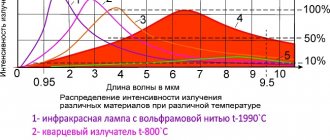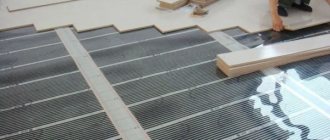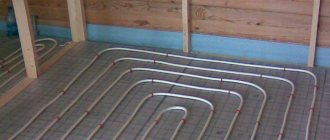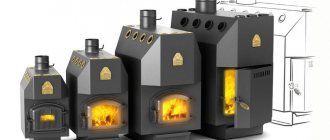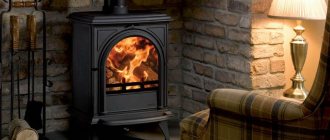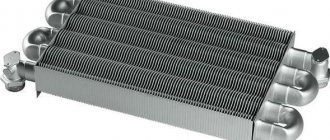Operating principle of the IR heater
The mechanism of action of all heating devices is based on the transfer of heat energy from objects that are hotter to less warm ones. The intensity of heat transfer increases if the temperature difference between the object and the environment increases.
There are 3 types of thermal energy exchange:
- thermal conductivity;
- radiation;
- convection.
All heating devices can supply energy in any of these ways.
Oil heaters and heating radiators using convection are able to provide the fastest possible transfer of thermal energy. Heat from the device is transferred to the layer of air in contact with it. It becomes lighter and rises quickly, while the cold, heavy air sinks down. This creates air circulation inside the room. Objects around are heated by the already heated air. The air temperature near the ceiling is always slightly higher than near the floor.
The transfer of heat by infrared heaters is based on the process of emission of infrared waves by devices. They quickly penetrate the air layer and are absorbed by solid objects, simultaneously heating them. Infrared heaters are often called "artificial sun". IR rays can spread through the air without any obstacles and hit objects and people. Surfaces heated in this way begin to generate heat themselves.
This type of thermal energy transfer is advantageous in that air does not take any part in it. Therefore, the efficiency of using the accumulated energy increases, which ensures the most uniform heating of the entire room.
Operating principles of “rapid heat”
The operating principle of an infrared heater is quite simple: electrical energy is converted into thermal radiation. Reflecting from the plates on the surface of the heater, thermal radiation is directed to the floor and various objects. Reflecting from these objects, heat is transferred to the environment. Due to the fact that long-wave rays heat objects rather than air, the heat in the room is better retained. An important point is that under the influence of an IR heater the amount of oxygen in the air does not decrease, which means that the air does not become dry and the room does not require additional humidification.
Energy saving when operating infrared heaters is achieved simultaneously in several ways. First of all, this occurs due to the rapid transfer of heat. A few minutes of operation of the device is enough to feel comfortable. Also, thanks to the action of thermal radiation, the average temperature in the room can be reduced by 1-2 °C, and a person in these conditions will not experience a lack of heat. Such a slight decrease in temperature brings a tangible economic effect in the form of 5% energy savings per degree.
Uneven heating is often a problem in rooms with high ceilings. With infrared heaters, this issue does not arise, since heating the entire volume of the room is absolutely the same, both near the floor and under the ceiling.
In order for the use of an IR heater to give maximum effect, it is necessary to correctly calculate the necessary equipment, its quantity and the height of the suspension. For the calculation, such parameters as room area, ceiling height, intended purpose of the heated room (housing, insulated warehouse, industrial building, etc.) are important.
Pros and cons of an infrared heater
To understand whether an infrared heater is necessary to heat a room, you need to study all the pros and cons of its operation.
The main advantages of an infrared heating system:
- the device does not require additional maintenance;
- it is easy to install;
- even a large room warms up quickly;
- you can independently create several heat zones in one large room;
- increased efficiency;
- there are no moving elements in the system, so the infrared heater operates silently;
- no foreign odors are released, and oxygen is not burned;
- increased fire safety so that the system can be used in wooden houses;
- The IR heater can be used in rooms with high humidity.
The advantages of an infrared heater are undeniable, but it also has certain disadvantages. Among them:
- high price;
- such a heating system can, over time, damage interior items that are deprived of moisture and, as a result, become covered with cracks;
- If you do not follow all the rules for using the device, you can cause irreparable harm to your health.
Where are infrared heaters used?
Among the many advantages of an infrared heater, it is worth noting its mobility. Since its connection does not require special devices, devices or the presence of a specialist, the IR heater can be used in any room and even outside. All you need is access to an electrical outlet and loops for hanging the heater. Some models may have a cable system with which the height of the device is adjusted. Their fastening also does not cause difficulties during installation of the device.
The scope of application of infrared heaters is quite extensive. IR heaters are suitable for any living room, including children's rooms, dining rooms, bedrooms, and winter gardens. But most often such heaters are installed in dachas, where this heating method is simply necessary. Arriving at a country house on a frosty winter day, you really want to get warmth instantly, and not wait several hours for the entire room to warm up.
But the use of IR heaters is not limited to residential premises. They are suitable for heating medical and health facilities, industrial warehouses, offices, cafes, airport buildings, bus stations, etc. With the help of infrared heaters, you can create comfortable conditions in open areas: stadiums, cafe terraces, etc. IR heaters also have a slightly different production function. Using thermal radiation, they maintain the required surface temperature, dry painted parts and accelerate the hardening process of concrete.
More articles on the site
- May the windows last a long time!
- 3 zodiac signs that hate dating sites
- 14 useful and important cooking tips
- How to line walls
- 3 zodiac signs that don't forgive infidelity
- About the dangers and benefits of high heels
- Lagoons of Bolshoy Utrish
- Summer holidays in Croatia
- How to choose a bathtub, tips for choosing
- 7 Best Houseplants for Purifying Indoor Air
- Christmas decorations: an alternative to glass
- Anti-burglary plastic windows
Where is the best place to install an IR heater?
Regardless of their intended purpose, ventilation systems collect air from floor to ceiling. Therefore, it is best to install heaters on the ceiling.
Ceiling heaters are not only efficient in operation, they are also very economical. When the temperature in the room decreases, less energy is consumed. There is no need to wait long for the air to heat up, since the system is configured to work instantly. All IR heaters are equipped with built-in thermostats and heating controllers. The equipment is modern, easy to operate, which allows you to create favorable conditions in the premises in a short time. The space is heated evenly. There are no worse or better heated areas.
Infrared heaters are effective when working with a ventilation system. It does not matter much whether air is supplied through the floor or from under the ceiling. Heat loss is compensated through good air exchange in the room. This allows you to achieve a comfortable microclimate in the room in a short time without additional expenditure of thermal energy.
How to choose an infrared heater
The optimal power is calculated using the formula: 1 kW of power per 10 square meters of room. The type of heating can be direct or indirect.
In the first case, it is best to additionally install a ventilation system, since combustion products flow back into the air. The indirect type implies an additional system for removing combustion products.
To understand which heater is better, you must pay attention to three important parameters:
- Wavelength. The temperature of the heat generated directly depends on this parameter.
- Device power. With power ratings in the range of 300-2000 W, the equipment is used in domestic conditions (apartment, house, office). In this case, a network voltage of 220 Volts will be sufficient.
- Installation method. Infrared heaters are installed on the wall, ceiling or floor. Devices mounted in the ceiling are more efficient in operation.
Scope of application of IR heaters
The use of IR heaters is not based exclusively on residential premises. IR radiation is used for:
- heating in greenhouses and hangars where young animals are kept;
- heating production workshops and barns;
- for heating premises reserved for cafes and restaurants;
- in medicine it is used for the purpose of disinfection;
- Saunas and special heating furniture are produced based on infrared rays.
Infrared heaters for domestic and industrial purposes differ in the type of main heating elements, that is, their emitting wavelengths are different. The difference lies in the very type of heated energy source.
Types of infrared heaters
There are several main types of infrared heaters. Infrared, when the wavelength is from 0.74 microns to 1 mm. This indicator will always be inversely proportional to the temperature of the heated surface. It is measured between the visible red part and the invisible microwave radiation.
Classification of devices according to the energy source used:
- gas - for large premises (greenhouses, hangars);
- electric – they independently create IR rays, designed for small rooms.
By type of main heating element:
- Carbon - the heater is a carbon spiral, which has a low heating temperature. At the same time, the waves are always long, which makes the heating soft and comfortable.
- Lamp - glowing bright golden color. The heating element is a tungsten or chromium-nickel filament, which is placed in an airless quartz tube. The waves are short because the temperature is too high. Such heaters are not recommended for use in residential areas as they are harmful to health.
- Ceramic – the radiated element is a large ceramic panel. It is heated using an initially mounted metal spiral. Such waves are soft and safe for the human body. Ceramics are good in operation, which allows the use of such heaters in educational institutions and in rooms with high humidity.
- Film - devices operating on long waves. They are represented by a thin film, the thickness of which does not exceed 1 mm. Film heaters are usually placed on walls, on the floor or under the ceiling. The radiation is quite soft.
- Micathermic - similar to ceramic heaters. The heating element is an oxidized metal plate, the shell of which is made of mica. Heating occurs due to chromium-nickel thread. The main difference is the small heat capacity of the heating element itself and the strong infrared effect.
Classification by wavelength:
- long-wave – due to the length of the transmitted waves, they provide the softest and most comfortable heating. Suitable for residential buildings and apartments;
- short-wave - intended for heating large rooms. May pose a hazard to human health.
Today, the most common are electric IR heaters made on the basis of lamp, ceramic and micathermic radiation elements.
Types and design of infrared heater
Any infrared heater consists of: 1) a housing 2) a heating element 3) a reflector (reflector) with thermal insulation 4) a mounting bracket 5) a thermostat and an auto-shutoff sensor (control unit).
Gas infrared heater device
The most popular type of infrared heater is electric . Due to the excellent balance between efficiency and durability, they are used in all three areas of application, from large train stations to small garages. Let's take a closer look at the components using his example.
The housing can be made from steel and aluminum, as well as from other various types of temperature-resistant plastic or glass. Thanks to this scheme, the electric infrared heater reflects radiation in the desired direction.
Several materials can play the role of a heating element in it: heating elements (tubular electric heaters), halogen lamps, ceramic lamps, carbon spirals or film micathermic panels. Heating systems with open elements (spiral) are becoming a thing of the past; they are being replaced by modern lamps and films. The difference between them is the resource of continuous use. Carbon lamps in infrared heaters are considered the most durable.
A reflector is provided for directed heat distribution. It is made from modern materials that have maximum reflectivity (for example, aluminum foil is used in film). The reflector is installed exclusively behind the heating element and is equipped with additional thermal insulation to protect the unit body from overheating.
What is an infrared heater ✮Large selection of infrared heaters on the TopClimat.ru portal
Such electric heaters are usually mounted on a floating mounting bracket, which is included in the factory kit. Less commonly, hangers are used as fastening. The easiest thing to do is with floor-mounted infrared heaters, which just need to be wisely chosen in the right place.
A variety of floor-standing models of infrared heaters.
Any modern infrared heater also has a temperature sensor with auto-shutoff or a control unit to protect against threats such as overheating or falling (for floor-standing models).
Gas infrared heaters are used more often for commercial and industrial premises. And only in non-residential premises. Similar to an electric infrared heater, gas heaters have the same components. The difference lies in the method of obtaining thermal energy:
Method one. The heating element is always special ceramic plates. These thin sheets of ceramic are heated using something similar to gas burners - small gas torches or a stream of exhaust gas. And in this case, combustion products do not come into contact with heating materials.
Method two. From a gas-air mixer under pressure, oxygen and gas are passed through ceramic plates and burns on their surface. With this method, the plates can be replaced with metal meshes. And combustion products enter a special drying section, where contact with heated materials occurs.
Significant savings when using this type of infrared heaters make them a recognized favorite for heating industrial premises, because gas is burned inside and the percentage of energy converted into heat is very high.
Infrared heaters using diesel fuel are identical to gas ones. It just uses standard diesel fuel instead of gas, which can be purchased at any gas station. They comply with all modern technical requirements. And a large number of mobile models and power options allow them to be used anywhere, from large industrial areas to heating small houses that do not have a gas supply.
What criteria to consider when choosing a heater
In order for the infrared heater to operate at full power, you should carefully select the type of device itself. Before purchasing an IR heater, you should clearly determine for what purpose it will be used. According to the recommendations of experts, you can adhere to the following standard principles:
- in order to heat a living space, it is better to use panels with low temperatures, that is, micathermic or ceramic;
- for heating large office spaces, it is recommended to use devices with an average heating temperature, made of safe carbon elements;
- To heat barns, greenhouses or large workshops, it is better to purchase electric and gas heaters that operate at high temperatures. It is recommended to place them as far as possible from people.
Before buying a heater, you need to study all its advantages and disadvantages, and only then choose a device that will bring warmth into the house and will not cause any harm to human health.
Climate control Heater
